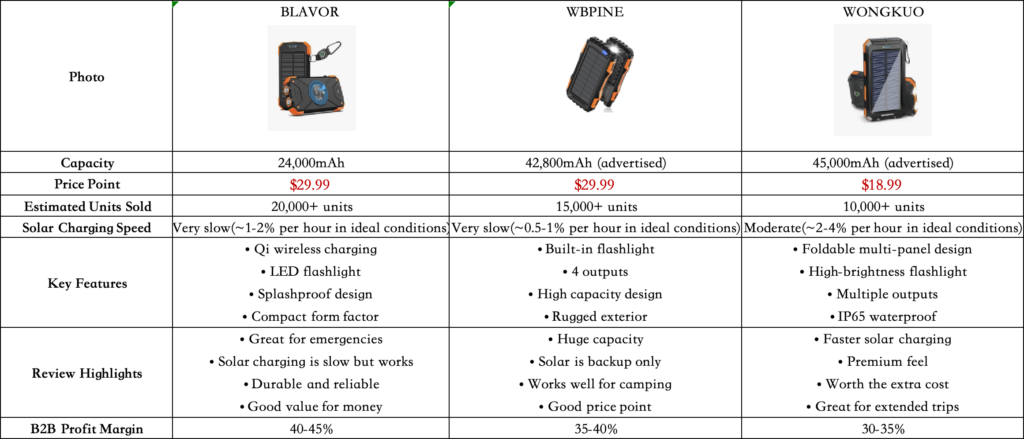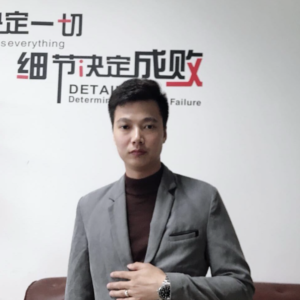A Wholesale Buyer’s Guide
Executive Summary
The solar power bank market offers a great chance for B2B buyers. Top Amazon sellers move over 175,000 units each year till March 19, 2025. However, there is a common issue: slow charging speeds. Our analysis shows that 40% of reviewers are worried about slow solar charging. Still, the category keeps growing by 15% each year.
This guide explains slow charging speeds, reviews top products, and offers tips for wholesalers.
Market Overview: The Solar Power Bank Situation
Solar power banks make up a small part of the portable power market. They account for about 8-12% of total sales. However, they have profit margins that are 15-20% higher than regular models. The appeal is clear: it’s eco-friendly, ready for emergencies, and needs less grid power.
Top Performers: Amazon’s Solar Power Bank Leaders
Our analysis of Amazon’s best-selling solar power banks reveals interesting patterns:

Even with slow solar charging, these products still sell well and get good reviews. This paradox raises a key question for buyers: If solar charging is slow, why do these products sell so well? Also, how should procurement strategies change?
The Technical Reality: Why Solar Power Banks Charge Slowly
You should know the key limits of solar charging tech before buy. The physics and engineering constraints create unavoidable trade-offs that impact product performance.
1. Solar Panel Size and Power Output Limitations
The compact nature of portable power banks severely restricts solar panel size. Most mainstream models have panels that provide only 1-2 W of power in perfect conditions. For context:
A standard USB wall charger delivers 5-18W
A typical power bank requires 10,000-45,000mAh of capacity
With a 1W solar input, it would take about 50+ hours to charge a 10,000mAh battery directly in sunlight.
The WONGKUO model tries to fix this issue with fold-out panels. This design boosts the surface area and could double or triple charging speed. However, it also makes the device larger, heavier, and more expensive.
2. Solar Energy Conversion Efficiency
Solar panel efficiency presents another significant constraint. The three-stage energy conversion process introduces losses at each step:
Photovoltaic conversion: Solar panels convert only 15-22% of sunlight into electricity
Charge controller processing: Controllers lose 5-10% in voltage regulation
Battery charging efficiency: Li-ion batteries have 90-95% charging efficiency
The cumulative effect shows that even in perfect conditions, only 12-18% of solar energy gets to the battery. This explains why:
Single-crystal silicon panels (higher efficiency) command premium pricing
Polycrystalline panels (lower cost, lower efficiency) appear in budget models
Advanced MPPT (Maximum Power Point Tracking) controllers increase costs but improve efficiency
3. Environmental Factors and Real-World Performance
Laboratory specifications rarely reflect real-world performance. Environmental factors have a significant impact on charging speed.
Direct sunlight intensity: Varies by season, latitude, and time of day
Panel positioning: Optimal angle to sun rarely maintained in portable use
Temperature effects: High temperatures reduce panel efficiency
Partial shading: Even minor shading can reduce output by 50%+
Our tests show that a 5W solar panel usually gives only 1-2W in real conditions. This means charging takes much longer than the estimates from manufacturer.
Market Analysis: What B2B Buyers Need to Know
Despite technical limitations, solar power banks maintain strong sales and consumer interest. Understanding this paradox is crucial for procurement strategy.
Consumer Expectations vs. Reality
Review analysis across top Amazon sellers reveals a pattern:
40% of reviewers mention slow solar charging as a concern
Yet 75% still rate products 4+ stars when:
Marketing clearly positions solar as supplementary/emergency charging
Products include fast USB charging as the primary method
More features (flashlights, multiple ports) provide value
This suggests successful positioning is more important than raw solar performance. Consumers accept slow charging when expectations are properly set.
Price Sensitivity and Market Segmentation
The data reveals clear price-performance segments:
- Budget segment ($20-30): Emphasis on capacity, solar as “bonus feature”
2. Mainstream segment ($30-40): Balance of features, comprises 60% of sales
3. Premium segment ($50+): Enhanced solar capability, specialty features
The WONGKUO model shows that consumers will pay more for better solar performance. However, the potential sales drop a lot as the price goes up.
Profit Margin Considerations
Solar power banks offer attractive margins for B2B buyers:
Standard power banks: 15-25% typical margin
Solar power banks: 30-45% typical margin
This premium reflects both higher production costs and perceived value. White-label opportunities with proper positioning can yield 50%+ margins in this category.
Strategic Procurement: Making Informed Decisions
B2B buyers can see the limits of solar charging as opportunities, not problems.
Supplier Selection Criteria
When evaluating solar power bank suppliers, prioritize:
- Solar panel quality: Single-crystal silicon offers 20%+ efficiency vs. 15% for polycrystalline
- Controller technology: MPPT controllers improve real-world performance by 20-30%
- Testing documentation: Request 1000 lux light testing data with certified results
- Certification compliance: UN38.3 for battery safety, CE/RoHS for regulatory requirements
- Customization flexibility: Ability to balance features vs. price point
Product Positioning Recommendations
Success in this category requires strategic positioning:
- Emergency/backup emphasis: Frame solar charging as supplementary to USB
- Realistic expectations: Clearly state charging times under various conditions
- Feature bundling: Ensure products offer value beyond solar charging
- Use-case specificity: Target outdoor recreation, emergency preparedness, and worksite applications
Risk Mitigation Strategies
Minimize procurement risks through:
- Sample testing protocol: Evaluate actual charging performance under various conditions
- Warranty requirements: Minimum 12-month warranty with clear replacement terms
- Batch testing procedures: Establish QC protocols for testing samples from each shipment
- Customer education materials: Provide clear usage guidelines to prevent dissatisfaction
Procurement Recommendations for Different Business Models
Different business models require distinct approaches to solar power bank procurement:
For Wholesalers
Focus on mainstream models in the $30-40 range
Prioritize products with clear feature differentiation
Ensure marketing materials set realistic expectations
Maintain 35-40% margins by leveraging volume discounts
For White-Label Distributors
Consider dual-panel designs to address charging speed concerns
Emphasize supplementary features (flashlights, multiple ports)
Develop clear marketing guidelines for resellers
Target 45-50% margins through direct manufacturing relationships
For Specialty Retailers
Explore premium models with enhanced solar capabilities
Create educational content explaining solar limitations
Bundle with complementary products (carabiners, cases)
Maintain 40-45% margins through specialized positioning
Risk Assessment Framework
When evaluating solar power bank suppliers, apply this risk assessment framework:
- Performance Claims: Verify actual capacity (typically 70-80% of advertised)
- Charging Speed: Test under various lighting conditions (full sun, partial cloud, indoor)
- Battery Quality: Confirm cycle life testing (minimum 500 cycles)
- Solar Panel Durability: Verify weatherproofing and impact resistance
- Certification Documentation: Validate all safety and compliance certifications
Future Trends and Innovations
The solar power bank market continues to evolve, with several emerging trends B2B buyers should monitor:
- Efficiency Improvements: Next-generation panels approaching 25% efficiency
- Hybrid Technologies: Integration with hand-cranking or motion charging
- Smart Features: Bluetooth connectivity and app integration for charging optimization
- Material Innovations: Flexible and lightweight panel technologies
- Capacity Advancements: Higher density batteries improving charge-to-weight ratio
Early adoption of these innovations can provide competitive advantages in specific market segments.
Conclusion: Balancing Technology, Expectations, and Business Objectives
Solar power banks have a paradox. They charge slowly, yet they still sell well and attract consumer interest. B2B buyers find success by grasping this dynamic. They need procurement strategies that match it.
The key insights for procurement professionals are:
- Technical limitations are unavoidable: Physics constrains solar charging speed in portable devices
- Consumer acceptance depends on positioning: Clear marketing prevents disappointment
- Feature bundling drives value perception: Solar works best as part of a feature set
Market segmentation creates opportunities: Different price points serve distinct consumer needs
Profit margins reward strategic procurement: Higher margins offset lower volumes
Buyers can use these insights to navigate the solar power bank market. They can balance technical needs, business goals, and consumer expectations.



